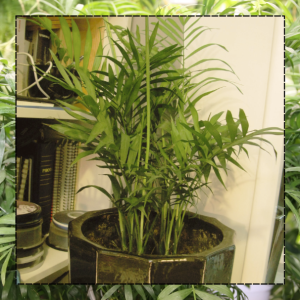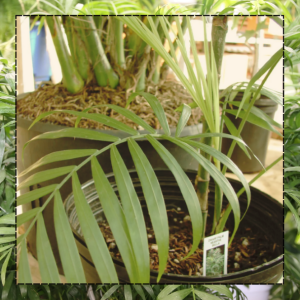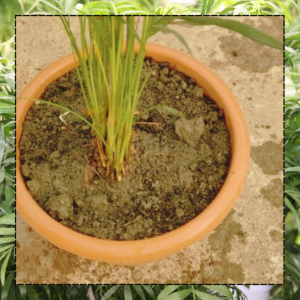HousePlantJoy is supported by our audience. When you purchase through one of our links, we may earn a small affiliate commission. As an Amazon Associate I earn from qualifying purchases. Your cost is not affected.
==================
Have you heard of the areca palm? Known for its elegant fronds, this plant is a favorite among houseplant lovers. It’s often called the butterfly or golden cane palm, adding a tropical flair to any space.
In this guide, we’ll explore all about the areca palm. We’ll cover everything from providing the right indirect light to moistening the soil. Whether you’re a seasoned green thumb or a newbie, you’ll find valuable tips here. Explore why the areca palm is a popular indoor garden choice.
The Areca Palm
The areca palm, often gracing our homes with its presence, is more than just an aesthetic delight. It’s a plant with a story, various names, and a rich origin.
The Many Names of the Areca Palm
You might know the areca palm as a butterfly or golden cane palm. Some even call it the bamboo palm because of its bamboo-like stems.
Each name reflects a unique aspect of its appearance and nature. For example, the ‘butterfly palm’ name comes from how its leaves curve upwards, resembling butterfly wings.
The Origin Story
Native to Madagascar, the areca palm has traveled far from its tropical roots to become a beloved houseplant worldwide. Known scientifically as Dypsis lutescens, it’s part of a more prominent family of palm trees. This journey from the exotic forests of Madagascar to our living rooms is a testament to its adaptability and charm.
A Botanical Marvel
The areca palm isn’t just about looks. It’s a natural air purifier known for removing indoor toxins. Also, it’s a source of peace and tranquility, often recommended for creating a calming atmosphere in homes and offices.
The Ideal Environment for Your Areca Palm
Selecting the perfect spot and conditions for your indoor areca palm is essential. Let’s look at how to create the ideal home for your palm.
Lighting and Location
Areca palms crave bright indirect light. You can find a spot that’s bathed in soft, filtered sunlight. East- or west-facing windows are perfect for avoiding the harsh midday sun.
Remember, too much direct sunlight can harm the delicate leaves of your plant.
Temperature and Humidity
- Maintain a steady temperature between 65-75°F (18-24°C). Areca palms don’t do well with sudden temperature changes.
- These palms thrive in moderate to high humidity. Aim for 40-60% to keep them happy.
- Consider using a humidifier to maintain humidity levels in dry environments.
Watering and Soil Requirements
Proper watering and suitable soil are vital for the health of your areca palm. Let’s break down these essentials.
Watering Do’s and Don’ts
Watering your areca palm correctly is crucial. The goal is to keep the soil moist but not soggy. Water the plant when the top inch of the soil feels dry.
Over-watering can lead to root rot, a common issue with these plants. In contrast, under-watering can cause the leaves to turn yellow and droop. It’s a delicate balance.
During fall and winter, reduce watering as the plant’s growth slows down.
The Perfect Soil Mix
The ideal soil for your areca palm is vital for drainage and nutrition. Use a well-draining potting mix. A blend of regular potting soil, peat moss, and coarse sand works well.
This mix helps keep the soil moist yet prevents water from accumulating at the roots. They prefer slightly acidic soil, so ensuring the correct pH is essential for their growth.
Avoiding Salt Build-Up
Fertilizers are great for providing nutrients but can leave salt deposits in the soil. These deposits can harm your palm.
Flush the soil occasionally by running water through it for a few minutes. This process removes fertilizer salt deposits, keeping the soil healthy for your palm.
By understanding and implementing these watering and soil tips, your plant will continue to grow and thrive in your home.
Feeding Your Areca Palm
Proper feeding is essential to keep your areca palm lush and healthy. Let’s delve into how to nourish your palm effectively.
Choosing the Right Fertilizer
Your areca palm benefits from extra nutrition, especially during its growing season. A balanced houseplant fertilizer works best for these palms. It should be applied carefully:
- Frequency – Fertilize once in spring and again in summer.
- Application – Follow the label instructions to avoid over-fertilizing.
- Monitor for Signs – Over-fertilization can cause fertilizer salt deposits, harming the plant.
The Benefits of Slow-Release Fertilizers
Slow-release fertilizers are excellent for areca palms. They provide a consistent nutrient supply over time. This method is less risky than liquid fertilizers and ensures a steady growth rate.
Handling Fertilizer Salt Deposits
Sometimes, fertilizer use can lead to salt buildup in the soil. These deposits are harmful to your areca palm. To manage this:
- Periodically flush the soil with water.
- Let the water run through for a few minutes.
- This process will wash away the excess salts.
Proper feeding is critical to maintaining the health and beauty of your palm.
Pruning and Maintenance
Pruning and regular maintenance are vital to keeping your areca palm healthy and looking its best. Let’s dive into how to care for your palm effectively.
Pruning
Pruning is essential for the areca palm, mainly to remove any brown or dying fronds that can sap energy from the plant. It’s not just about aesthetics but about health, too.
Use a sharp knife or pruning shears, and always cut cleanly near the base of the frond. Be cautious not to over-prune, as each frond contributes to the palm’s overall health and growth.
Maintaining a Healthy Plant
Regular maintenance goes beyond pruning. Here are some key aspects:
- Keep an Eye on the Soil – Ensure the soil remains moist but not waterlogged.
- Watch for Pests – Common houseplant pests like spider mites can affect areca palms. Inspect your palm regularly.
- Clean the Leaves – Dust can accumulate on the fronds. Gently wipe them with a damp cloth to keep them clean and able to breathe.
Dealing with Common Problems
Occasionally, your areca palm may face root rot or insect-transmitted bacterial diseases. I want you to know that root rot often stems from over-watering, so please be vigilant about your watering schedule.
Please treat pests and diseases as soon as possible with appropriate remedies, always considering the health and safety of your home environment.
Caring for your palm through pruning and regular maintenance ensures a healthy, vibrant plant.
Repotting
Repotting becomes essential as your plant grows to give it the space it needs. Let’s explore the right way to repot your palm.
Knowing When to Repot
Repotting is vital for the growth of your areca palm. Look for signs like crowded roots or roots growing through the drainage holes.
These indicate it’s time for a larger home. Typically, repotting every two to three years is sufficient.
Choosing the Right Pot
Select a new pot that’s slightly larger than the current one. Ensure it has ample drainage holes to prevent waterlogging. A pot that is too large can lead to excess soil moisture, causing root problems.
The Repotting Process
Repotting should be done carefully to avoid damaging the root ball of your areca palm. Here’s a step-by-step guide:
- Prepare the New Pot – Fill it with a suitable potting mix, ensuring good drainage.
- Remove the Palm Gently – Tip the current pot and gently ease the palm out, careful not to disturb the root ball excessively.
- Place in the New Pot – Set the palm at the same depth as in the old pot. Fill around the roots with more potting mix.
- Water Thoroughly – After repotting, water the plant to settle the soil and eliminate air pockets.
Post-Repotting Care
After repotting, place your areca palm in a location with bright indirect light. Avoid fertilizing immediately. Give it a few weeks to adjust to its new home.
Repotting your areca palm gives it the necessary space to continue thriving.
Special Care Tips for Different Seasons
Your areca palm has different needs as the seasons change. Let’s look at how to care for it throughout the year.
Spring and Summer Care
During spring and summer, the plant experiences its primary growing season. This is the time for more frequent watering and fertilization. The plant will use more water as the weather warms up, so keep the soil moist.
It’s also the perfect time to apply a balanced houseplant fertilizer. Increase humidity if possible, as the warmer months can dry the air.
Fall and Winter Care
In fall and winter, your areca palm’s growth slows down. Reduce watering since the plant uses less water in cooler temperatures. Let the soil dry out a bit more between waterings.
Hold off on fertilizer during these months, as the plant is not actively growing. Keep your palm away from cold drafts and sudden temperature drops, especially when temperatures dip outside.
Adapting your care routine to the changing seasons will keep your areca palm healthy year-round.
The Benefits of Having an Areca Palm in Your Home
Areca palms are more than just decorative plants. They offer several benefits that enhance your living space. Let’s explore why having an areca palm in your home is a great choice.
Air Purification Properties
One of the most celebrated benefits of the areca palm is its ability to purify the air. It’s known for removing toxins and improving indoor air quality. This makes the areca palm a visual delight and a functional addition to your home.
Aesthetic and Psychological Benefits
- The lush greenery of areca palms adds a touch of nature to any room, enhancing its aesthetic.
- Being around green plants like the areca palm can boost mood and reduce stress.
- The presence of this palm can create a serene environment in your home.
Comparative Advantages Over Other Houseplants
While many plants offer benefits, the areca palm stands out for its ease of care and versatility. It adapts well to indoor environments, making it a more forgiving choice for those new to houseplants. Its unique appearance, with arching fronds and a graceful structure, also sets it apart from other common houseplants.
Having an areca palm in your home brings beauty, health benefits, and a calming presence.
Video Credit: @GardenUp
Wrapping It Up
This charming plant is more than just a decorative element. Its ability to purify the air and its aesthetic appeal makes it a valuable addition to any home. Whether you’re a seasoned plant lover or new to houseplants, the areca palm is a delightful and forgiving companion.
Remember, caring for an areca palm is a journey. There will be learning and adjustments along the way. Don’t be discouraged by the occasional brown tip or a dropped frond.
These are just part of the natural cycle and growth of your palm. With the proper care and attention, your areca palm will thrive, bringing a piece of tropical paradise into your living space.
We hope this guide has equipped you with all you need to know about nurturing and enjoying your areca palm. Feel free to revisit these tips as your palm grows and adapts to its home.
And most importantly, enjoy the process! After all, growing with your plants is one of the most rewarding experiences.
Happy planting!
Frequently Asked Questions
Is the Areca Palm Toxic to Pets?
Good news! Areca palms are non-toxic to cats and dogs, making them pet-friendly houseplants.
How Often Should I Water My Areca Palm?
Water your areca palm when the top inch of soil feels dry. This usually means watering every 7-10 days.
What’s the Best Fertilizer for an Areca Palm?
Use a balanced houseplant fertilizer during the growing season, in spring and summer. Avoid over-fertilizing to prevent salt deposits.
Can Areca Palms Grow in Low Light?
Areca palms prefer bright, indirect light. They can tolerate low light, but their growth may slow down.
Why Are the Tips of My Palm Turning Brown?
Brown tips can be due to low humidity, over-fertilizing, or irregular watering. Check these factors to address the issue.
Learn More About Houseplants!
Discover more types of houseplants, their benefits, and how to care for them with us! Join us on Facebook, Instagram, and Twitter for beautiful photos, plant care tips, and a community that celebrates the joy of indoor gardening.
Facebook: https://www.facebook.com/houseplantjoyblog
Instagram: http://instagram.com/houseplantjoy20
Twitter: https://twitter.com/HouseplantJoy
Let’s nurture our green spaces together!











